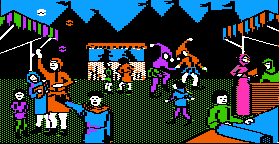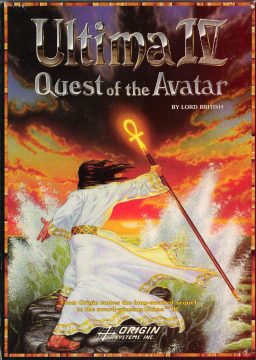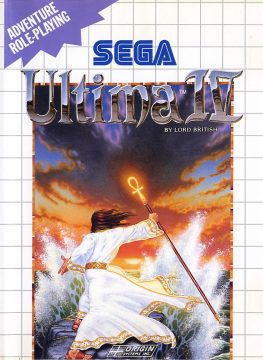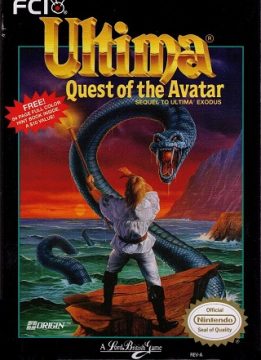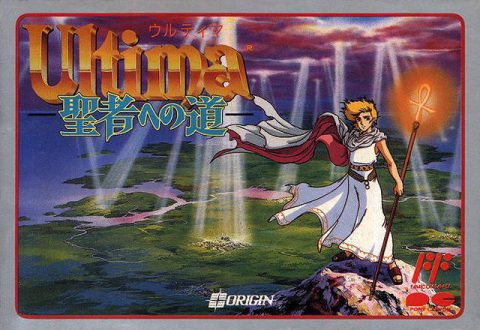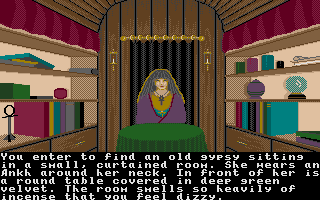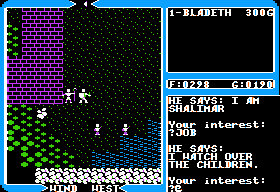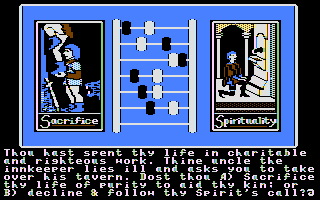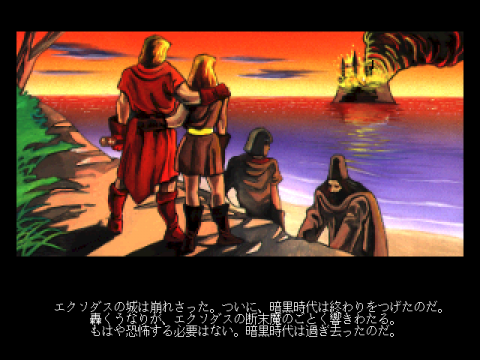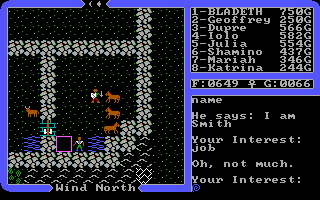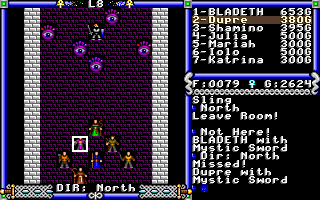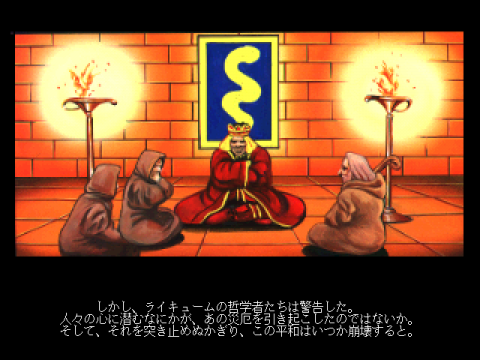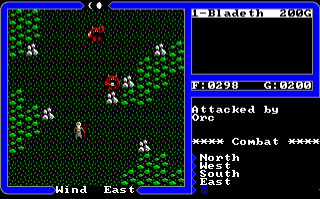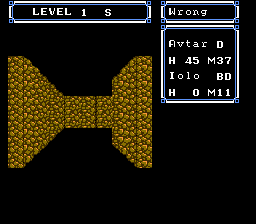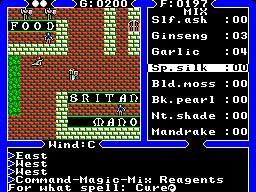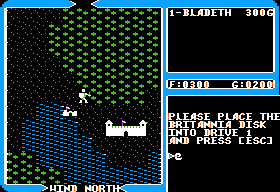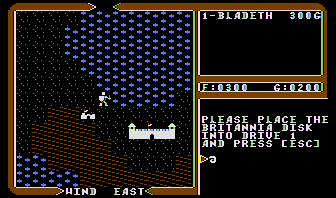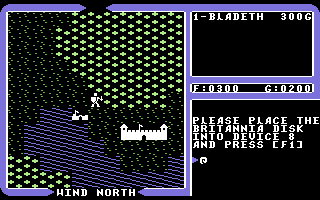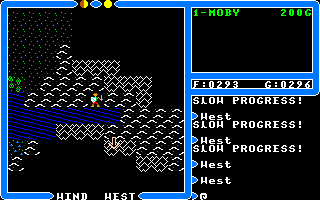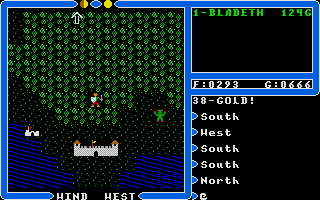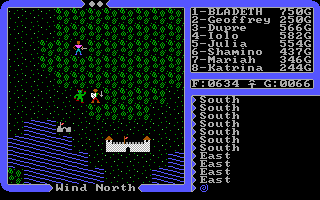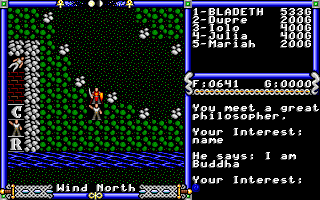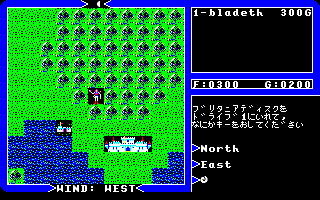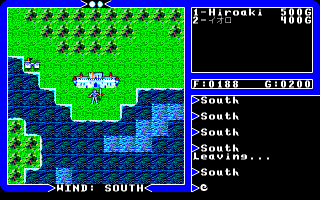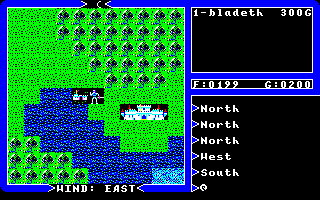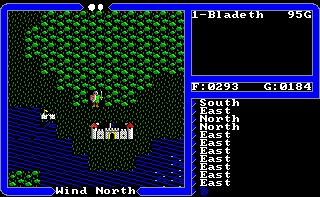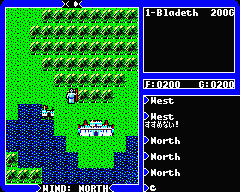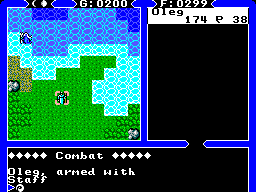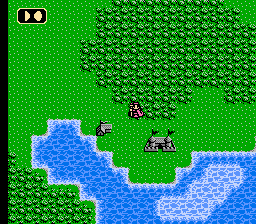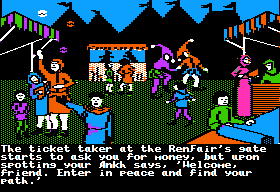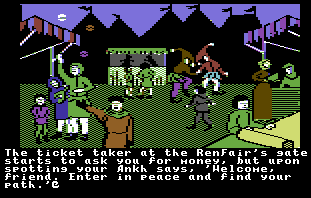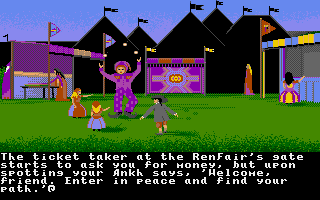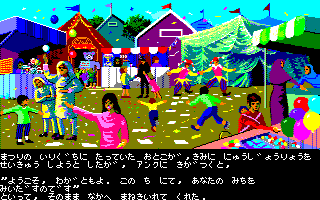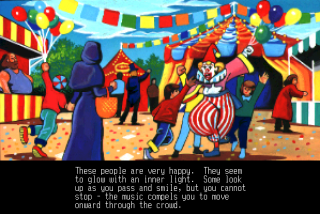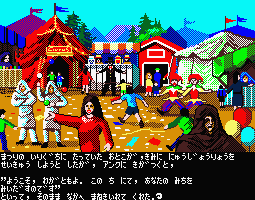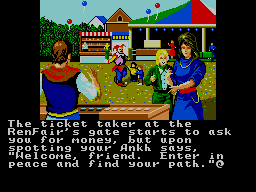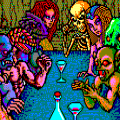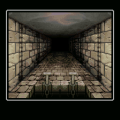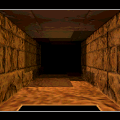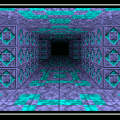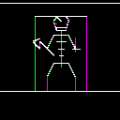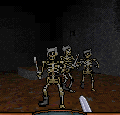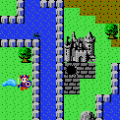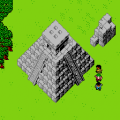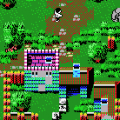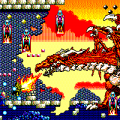- Ultima (Series Introduction)
- Akalabeth
- Ultima I: First Age Of Darkness
- Ultima II: Revenge of the Enchantress
- Ultima III: Exodus
- Ultima IV: Quest Of The Avatar
- Ultima V: Warriors of Destiny
- Ultima VII: The Black Gate
- Ultima VI: The False Prophet
- Ultima VII Part 2: Serpent Isle
- Ultima VIII: Pagan
- Ultima Underworld: The Stygian Abyss
- Ultima Underworld II: Labyrinth of Worlds
- Arx Fatalis
- Worlds of Ultima: The Savage Empire
- Ultima Worlds of Adventure 2: Martian Dreams
- Ultima IX: Ascension
- Lord of Ultima
- Ultima Online
- Ultima: Escape from Mt. Drash
- Ultima: Miscellaneous
- Richard Garriott (Interview)
It is a warm and happy day outside, but you find yourself unable to enjoy it, being beset by a serious of personal crises that occupy your mind. Perhaps that’s how you managed to wander right into the mysterious renaissance faire without even noticing it was there. Drawn inexplicably into the tent of the gypsy fortune-teller as if being led by some unknown force, you are welcomed as if expected, and given a most unusual reading. You feel as if the fortune-teller is trying to take your measure, to determine what sort of person you are. After answering to her satisfaction, you suddenly find yourself in a strange land…
The Age of Darkness is over with the last of Mondain’s evil legacy slain, and Lord British has organized the land of Sosaria, now Britannia, around a philosophical search for self-improvement. To this end he has created a system of eight virtues and three principles: Truth, Justice, and Courage, composed of honesty, compassion, valor, justice, honor, spirituality, sacrifice and humility. Society has been restructured around these virtues, and each of Britannia’s eight major cities is devoted to the pursuit of a single virtue. What this new enlightened Britannia needs now is not someone to slay a great evil, but someone to become a paragon of the virtues, the Avatar, who will be an example for the Britannians to look up to. Lord British calls upon the Stranger who thrice saved Sosaria to be this symbol for the new peaceful world, by living a life in accordance with the virtues and retrieving a lost book, the Codex of Ultimate Wisdom, from the bottom of a deep, dark dungeon called the Great Stygian Abyss.
Understanding the creation of Ultima IV requires some historical background. Back in the 1980s, due to multiple factors including the rise of a unique kind of American fundamentalist Christianity and the influence of sensationalist “autobiographical” book Michelle Remembers, a moral panic about Satanism and satanic ritual abuse rose and made waves in the US and then the world. Allegations of bizarre ‘satanic rituals’ involving animals and children spread thanks to dubious therapeutic and psychiatric techniques which encouraged preschool children to admit to suffering such abuse. Several preschool teachers and others were convicted of such ritual abuse during the height of the panic, and this inspired parents to begin searching for signs of ‘Satanism’, seeing such things where there were none, as people in the throes of moral panic tend to. One grieving mother named Patricia Pulling, whose son had committed suicide, was inspired to place the blame on the popular tabletop RPG he used to play, Dungeons & Dragons, which she accused of encouraging various antisocial behaviors such as ‘occultism, satan worship, sexual perversion’ and others. Dungeons & Dragons publisher TSR found itself under fire from parent’s groups and conservative Christian groups for supposedly encouraging ‘devil worship’, promoting ‘real magic’ and other such nonsense. No matter how nonsensical or hysterical the accusations during the moral panic’s height were, however, fantasy game authors everywhere felt the economic effects. Richard Garriott himself, now in his mid-twenties and flush with success from sales of Ultima III, found himself on the receiving end of angry letters from parents accusing him of promoting occultism and satanism with his games (presumably based on the cover of Ultima III, which portrays villain Exodus as a gargoyle-like demonic being).
Baffling and stupid as this was, it put the Ultima creator to thinking. Concluding that role-playing games, including his own, were actually about killing, gathering loot and gaining power instead of anything that resembled heroism or role-playing, he sought to try something different for his next game. Ultima IV: The Quest of the Avatar is the result, and is still a wholly unique product in computer gaming history. There are bad guys but no villains, and while there is still dungeon-crawling, it is not to acquire gold and magic items. Instead, the end goal of Ultima IV is to become a hero.
This world is very different from the Sosaria of the past. After the defeat of Exodus at the end of Ultima III, great shifts in the landmass changed the face of the world, and Lord British has once again united Sosaria under his rule while rebuilding. Now the land is called named for him by a thankful populace, and without the great evil of Mondain’s legacy hanging over the land, the people are united by pursuit of the Britannian Virtues. The game opens with a lengthy introduction movie, depicting the player stumbling his way into a fortune-teller’s tent and answering a series of questions, each depicting a situation with more than one possible “right” answer and asking the player to choose one. These questions align the player to a specific one of the virtues and set their starting location and character class; for instance, allying with Honor would result in the budding new Avatar starting play as a Paladin outside the city of Trinsic. Eight towns embody the study and pursuit of one of the virtues, and with the help and advice of Lord British and his seer Hawkwind, the player must come to embody them all on his way to being Avatar. Gameplay involves visiting the towns, talking to the inhabitants for clues, meditating at virtue shrines, and building your affinity for each of the virtues through right action. To show Compassion, for instance, the player can donate gold to the beggars in some towns, while overpaying a blind merchant shows Honesty. Ultimately, after coming to embody each of the virtues and gathering a party of Companions representing the rest of the available professions, the player is ready to venture to the bottom of the Great Stygian Abyss in search of the Codex.
Ultima IV is the first of the “modern” Ultima games. In Quest of the Avatar, Britannia becomes its own distinct world. Gone are Sosaria’s dwarves and elves and space-ships and phaser guns. In their place is a world with features that will remain recognizable and familiar between games. While the world map changed completely from game to game in the Age of Darkness, from Quest of the Avatar on Britannia stays the same shape, with cities and geographic features in the same locations. It’s unclear if the player-character in the previous games was intended to be the same person each time, but starting with Ultima IV, the player is given a specific identity, and you are the Avatar for the rest of the series, growing with the Ultima world.
Britannia has vastly increased detail, with scores of unique NPCs each with something different to say, more varied landscapes, more colors, more well-animated tile graphics and larger and more detailed towns. Gold, food and equipment is now shared in a party pool instead of being carried individually, eliminating one of Exodus‘ most annoying traits. Galleons now have facing, and can only fire cannons from the broadside. Combat screens now have terrain features to consider instead of being flat fields. Spellcasting no longer has a meaningful divide between holy and sorcery magic and now instead is based on a ‘reagents’ system, where the player must mix different ingredients such as ginseng and spider silk together in the right recipe to prepare spells; this system would remain in place for the rest of the series.
Perhaps most endearingly to fans of the games, there are now a large number of named characters who would go on to become permanent fixtures in Britannia alongside Lord British, including court jester Chuckles, the bard pair Iolo and Gwenno, spiritual ranger Shamino, alcohol-loving paladin Dupre, and various others collectively referred to as the Companions of the Avatar. Many of these people had existed in previous games, but starting with Ultima IV they were assigned roles and personalities, which were expanded to create characters with depth starting in the next installment. All the Companions of the Avatar and several other NPCs are based on real people, friends of Richard Garriott from his school days or his activities with a Texas-based chapter of the Society for Creative Anachronism. Moreso than previous games the influence of the SCA can be seen in Britannia, which now resembles something of an idealized, enlightened medieval world.
Even decades after Ultima IV‘s release there still isn’t another role-playing game quite like it. While most CRPGs focus on simulating the rules and mathematics of pen-and-paper RPGs, Quest of the Avatar focuses on simulating the role-playing aspect foremost, with nary a linear cliche-ridden JRPG-style fetch quest or hours of grinding to buy the copper sword in sight. Indeed, the dungeon-crawling feels like it was put in simply because it was expected to be there, not because it adds anything in particular, and is the least entertaining part of the game (Tip: stock up on Dispel, Cure Poison and Blink magic). Quest of the Avatar does not try to distract the player overly much from their primary goal of exploring Britannia, finding the towns and shrines and talking to people to further their understanding of the Virtues.
Combat is fast-paced (though it does still take far too long with the full possible eight-member party), and while gold and experience can be gathered from slaying evil monsters and bandits, it also serves as an opportunity to raise the player’s affinity for particular virtues; it is not exactly Just or Compassionate to wantonly slaughter non-evil animals like snakes, and it is certainly not Valorous to run away from thieves or marauding orcs. The game requires thought in every action, even the most seemingly insignificant. One cannot become the Avatar by murdering guards for experience points and keys, stealing food from McDonald’s stand-ins or slaughtering everything in sight, behavior all necessary in earlier games in the series (and most CRPGs before and since). Every virtue must be in balance, and being the most valorous, honorable fighter in the world doesn’t look so good when you go barging into people’s houses grabbing everything not nailed down, or when asked proudly declaring “Yes, I am the best swordsman in the world!”. Pride is not a virtue, Avatar.
Quest of the Avatar was, like all games in the series so far, originally released for the Apple II. The Apple II platform was clearly showing its age by 1985, however, and most machines did not have the memory necessary to run the game, requiring an expensive upgrade for Apple II gamers. In addition, the game does have a few strange colors due to the limitations of the Apple II’s palette. The C64 and Atari 8-bit ports are not terrifically different from the Apple II original, but with better colors and sound support. The C64 version unfortunately has extremely long loading time, and playing this version requires patience. Quest of the Avatar was the last Ultima game to receive a port for Atari 8-bit computers. The same Commodore 64 demo group who released an upgraded Ultima III Gold, Big Happy People, have released a similar upgrade of the C64 port of Ultima IV, called Ultima IV Gold, which fixes the loading issue along with a host of other glitches and problems with the game.
The IBM PC port for Ultima IV is an in-between step between the 8-bit computer versions and the later Atari ST and Amiga editions. The game was available in both CGA composite monitor mode as well as the more colorful 16-color EGA standard, resulting in a DOS Ultima that for once doesn’t invoke bleeding eyes on current machines. While the DOS version is a bit more colorful than the 8-bit computer versions, it lacks music and all sound effects come out of the PC speaker due to the hardware limitations of IBM PC machines in 1985. As with the previous two IBM PC ports in the series, a fan-made upgrade patch is available for Quest of the Avatar, this time adding in the game’s music and upgrading the graphics to VGA standard, putting the DOS port not only on par with the Amiga and Atari ST editions, but actually making it look a bit better than Warriors of Destiny. Again, the 16-bit Amiga and Atari ST versions are essentially identical and thanks to the graphical power of these platforms, both look and sound fantastic and offer mouse support. Without the fan upgrade to bring Ultima IV DOS up to their level or the use of the fan-made xu4 source port, these versions of the game are the most technically superior versions. The western computer versions of the game were the first to include more extensive feelies in the packaging besides the traditional cloth map, with a metal Ankh of Life amulet like the one worn in-game as well as extensive and detailed documentation in two volumes, written as in-universe guides.
Pony Canyon is responsible for the Japanese computer ports of Ultima IV, taking over from Star Craft and releasing the game on nearly every available Japanese computer system of the time. Thanks largely to this Ultima IV has more versions than any other game in the series. The PC-88, Fujitsu FM-7, Sharp X1 and MSX2 versions use the same redrawn tileset as Pony Canyon’s remakes of the first three games, while their PC-98 and Sharp X68000 versions look particularly crisp due to the more powerful nature of these machines. The FM Towns version, released on CD by Fujitsu, replaces the graphic tiles with the graphics from the Western 16-bit versions of Ultima V, for a very different game look. The FM Towns version also, carrying on the tradition, includes an exclusive introduction movie with very detailed painted art.
Like Exodus, Quest of the Avatar received a console port to the Nintendo Entertainment System thanks to Pony Canyon, with changes largely similar to the previous game’s treatment. The graphics and visuals, in addition to the menu-driven controls, now function much more like typical console JRPGs of the era when it was released. Like in the NES Exodus, food is no longer tracked, and the Ultima GUI is gone, with the play window filling the entire screen and commands executed by menus. The most severe changes to the game include the removal of the introduction entirely (at game start the player is immediately at the fortune-telling sequence), the removal of most of the ending sequence, a party size limited to four maximum (though all party members can be recruited, only three can be taken with you at any time and the rest wait in Lord British’s castle), and helpfully, a streamlining of the magic system where a spell can be cast as long as the player has the proper ingredients, without having to prepare them beforehand. The magic system in the NES port is quite different, requiring that spells first be stamped into a spellbook before they can be used, a service which does not exist in the original computer version. The music in this game is a great improvement over the grating bleeps and drones of Exodus’ NES port, which significantly improves the experience. One thing that makes the game somewhat harder is that monsters have no sense of self-preservation and will never run in the NES version, even non-evil ones, which makes building Compassion, Valor and Justice somewhat more difficult. Like many RPGs released in North America before Final Fantasy VII made RPGs the hip and cool genre in 1997, Ultima: Quest of the Avatar had an expanded manual that included a full game walkthrough, similar to the North American releases of Final Fantasy, Phantasy Star II and Earthbound. The cartridge is cheap and easy to acquire, but the manual is significantly rarer.
In addition to the port to a Nintendo system, Quest of the Avatar is also the only game in the series to receive a port to a Sega console. The Master System version of Ultima IV is a very rare cartridge in the United States, being published a year after the release of the Genesis and the working end of the sytem’s life-cycle in the US, but is much more common in Europe where Sega’s consoles have always had more of a commercial foothold. It was never released in Japan. The Master System port is mostly faithful to the computer versions of the game, unlike the radically different NES port, even including the original cover art and documentation and a paper replica of the cloth map of Britannia. The tile graphics are in the same overall style as the computer versions of the game, and gameplay is ported faithfully with only a few significant deviations. Unlike in the computer versions where the player can say anything they can type to an NPC, conversation topics in this version are limited to things the player has already discovered, and dungeons are overhead mazes rather than first-person crawls. While the Master System is clearly capable of Ultima-style first-person dungeon crawling (as shown in Sega’s fantastic 1987 Master System exclusive and obviously Ultima-inspired Phantasy Star), the use of overhead perspective in dungeons actually makes the game a bit easier and dungeon-crawling less tedious, due to it being easier to navigate.
Ultima IV is one of Richard Garriott’s favorite games in the series, and between 1997 and 2001, pressure from him and various fans associated with the Ultima Dragons fan club resulted in Electronic Arts (the series’ current copyright owners) giving permission to a select few places to distribute the game as freeware. Very recently (early 2011), Electronic Arts began issuing a series of DMCA notices and cease and desist orders to various websites hosting versions of Ultima IV for download, including a Flash-based browser version of the game and a website offering a browser-based version of the Sega Master System port. Electronic Arts themselves have launched an ‘Ultima 31st Anniversary Retrospective’ website at ultimaforever.com which allows the IBM PC version of Quest of the Avatar to be downloaded for free directly from them, and a version of the game was recently made available for free at Good Old Games. Quest of the Avatar is the only game in the series to have been released legally as freeware.
Links:
Free download of Ultima IV by Electronic Arts
Free download of Ultima IV at gog.com
Ultima IV fan-patches
SMSPower! Entry on the sega master system port.
Fansite focusing on the NES port.
Replacement copy of the NES version’s documentation.
Ultima IV Gold by Big Happy People
Clarification of Ultima IV’s legal status
Comparison Screenshots – Overworld
